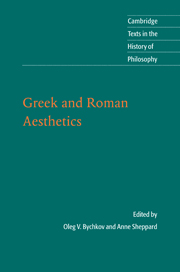Book contents
- Frontmatter
- Contents
- Preface
- Introduction
- Chronology
- Further reading
- Note on the texts and the translations
- Greek and Roman Aesthetics
- Gorgias
- Plato
- Xenophon
- Aristotle
- Philodemus
- Cicero
- Seneca
- Longinus
- Philostratus
- Philostratus the Younger
- Aristides Quintilianus
- Plotinus
- Augustine
- Proclus
- Index
- CAMBRIDGE TEXTS IN THE HISTORY OF PHILOSOPHY
Philostratus the Younger
Published online by Cambridge University Press: 05 June 2012
- Frontmatter
- Contents
- Preface
- Introduction
- Chronology
- Further reading
- Note on the texts and the translations
- Greek and Roman Aesthetics
- Gorgias
- Plato
- Xenophon
- Aristotle
- Philodemus
- Cicero
- Seneca
- Longinus
- Philostratus
- Philostratus the Younger
- Aristides Quintilianus
- Plotinus
- Augustine
- Proclus
- Index
- CAMBRIDGE TEXTS IN THE HISTORY OF PHILOSOPHY
Summary
Pictures
Preface 3–7
The practice of painting is most noble and concerned with matters of no small significance. One who is going to master the art correctly must have thoroughly studied human nature. He should be able to discern the signs of people's characters even when they are silent, understanding what appears in the state of the cheeks, the expression of the eyes, the character of the eyebrows and, in short, everything which shows what they are thinking. Once he has sufficient grasp of these he will put everything together and his hand will successfully interpret the story appropriate to each subject, whether a madman, perhaps, or someone in a rage, or thoughtful, or happy, or impulsive, or in love and, in a word, he will paint what is fitting for each one. There is a pleasant deception involved, with no blame attached; surely encountering things which are not real as if they were real and being led by them to think that they are real, in a way which causes no harm, is enough to provide attractive and blameless entertainment?
I think that wise men of old wrote a great deal about symmetry in painting, laying down rules, as it were, for the proportion of each of the limbs, as if it were not possible to convey mental agitation really well unless the arrangement of the limbs conformed to the natural measurements; according to them an abnormal figure, which exceeds these measurements, cannot convey agitation of a normal nature.
- Type
- Chapter
- Information
- Greek and Roman Aesthetics , pp. 171 - 172Publisher: Cambridge University PressPrint publication year: 2010

